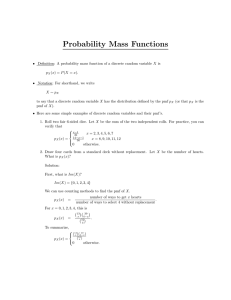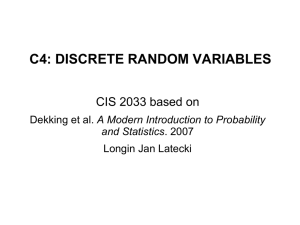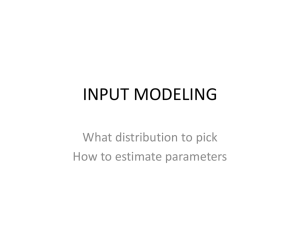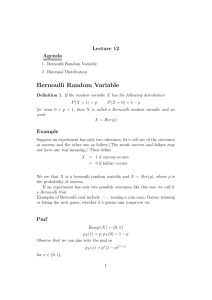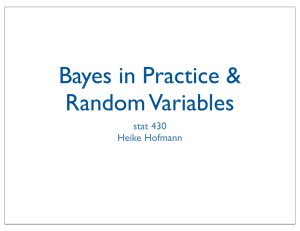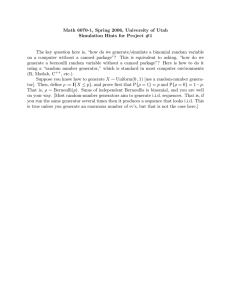Discrete Class Jeremy 1
advertisement
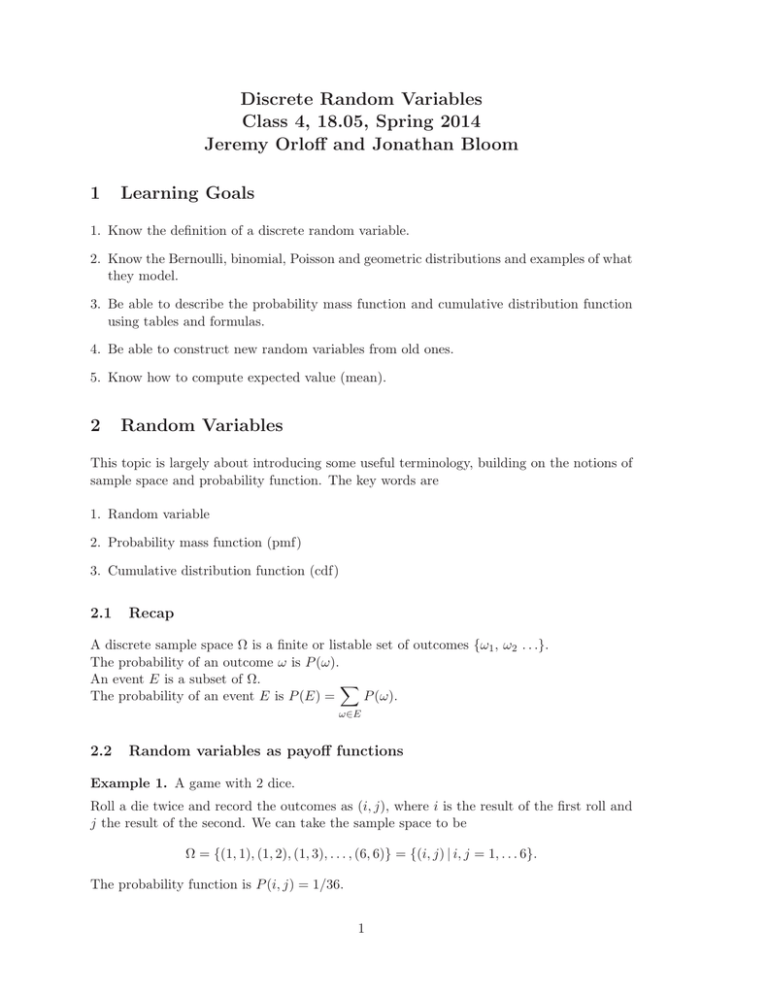
Discrete Random Variables
Class 4, 18.05, Spring 2014
Jeremy Orloff and Jonathan Bloom
1
Learning Goals
1. Know the definition of a discrete random variable.
2. Know the Bernoulli, binomial, Poisson and geometric distributions and examples of what
they model.
3. Be able to describe the probability mass function and cumulative distribution function
using tables and formulas.
4. Be able to construct new random variables from old ones.
5. Know how to compute expected value (mean).
2
Random Variables
This topic is largely about introducing some useful terminology, building on the notions of
sample space and probability function. The key words are
1. Random variable
2. Probability mass function (pmf)
3. Cumulative distribution function (cdf)
2.1
Recap
A discrete sample space Ω is a finite or listable set of outcomes {ω1 , ω2 . . .}.
The probability of an outcome ω is P (ω).
An event E is a subset of Ω.
The probability of an event E is P (E) =
P (ω).
ω∈E
2.2
Random variables as payoff functions
Example 1. A game with 2 dice.
Roll a die twice and record the outcomes as (i, j), where i is the result of the first roll and
j the result of the second. We can take the sample space to be
Ω = {(1, 1), (1, 2), (1, 3), . . . , (6, 6)} = {(i, j) | i, j = 1, . . . 6}.
The probability function is P (i, j) = 1/36.
1
18.05 class 4, Discrete Random Variables, Spring 2014
2
In this game, you win $500 if the sum is 7 and lose $100 otherwise. We give this payoff
function the name X and describe it formally by
X(i, j) =
500
−100
if i + j = 7
if i + j = 7.
Example 2. We can change the game by using a different payoff function. For example
Y (i, j) = ij − 10.
In this example if you roll (6, 2) then you win $2. If you roll (2, 3) then you win -$4 (i.e.,
lose $4).
Question: Which game is the better bet?
answer: We will come back to this once we learn about expectation.
These payoff functions are examples of random variables. A random variable assigns a
number to each outcome in a sample space. More formally:
Definition: Let Ω be a sample space. A discrete random variable is a function
X: Ω→R
that takes a discrete set of values. (Recall that R stands for the real numbers.)
Why is X called a random variable? It’s ‘random’ because its value depends on a random
outcome of an experiment. And we treat X like we would a usual variable: we can add it
to other random variables, square it, and so on.
2.3
Events and random variables
For any value a we write X = a to mean the event consisting of all outcomes ω with
X(ω) = a.
Example 3. In Example 1 we rolled two dice and X was the random variable
X(i, j) =
500
−100
if i + j = 7
if i + j = 7.
The event X = 500 is the set {(1,6), (2,5), (3,4), (4,3), (5,2), (6,1)}, i.e. the set of all
outcomes that sum to 7. So P (X = 500) = 1/6.
We allow a to be any value, even values that X never takes. In example 1, we could look at
the event X = 1000. Since X never equals 1000 this is just the empty event (or empty set)
‘X = 1000' = {} = ∅
P (X = 1000) = 0.
18.05 class 4, Discrete Random Variables, Spring 2014
2.4
3
Probability mass function and cumulative distribution function
It gets tiring and hard to read and write P (X = a) for the probability that X = a. When
we know we’re talking about X we will simply write p(a). If we want to make X explicit
we will write pX (a). We spell this out in a definition.
Definition: The probability mass function (pmf) of a discrete random variable is the func­
tion p(a) = P (X = a).
Note:
1. We always have 0 ≤ p(a) ≤ 1.
2. We allow a to be any number. If a is a value that X never takes, then p(a) = 0.
Example 4. Let Ω be our earlier sample space for rolling 2 dice. Define the random
variable M to be the maximum value of the two dice:
M (i, j) = max(i, j).
For example, the roll (3,5) has maximum 5, i.e. M (3, 5) = 5.
We can describe a random variable by listing its possible values and the probabilities asso­
ciated to these values. For the above example we have:
value
a:
pmf p(a):
For example, p(2) = 3/36.
Question: What is p(8)?
1
1/36
2
3/36
3
5/36
4
7/36
5
9/36
6
11/36
answer: p(8) = 0.
Think: What is the pmf for Z(i, j) = i + j? Does it look familiar?
2.5
Events and inequalities
Inequalities with random variables describe events. For example X ≤ a is the set of all
outcomes ω such that X(w) ≤ a.
Example 5. If our sample space is the set of all pairs of (i, j) coming from rolling two dice
and Z(i, j) = i + j is the sum of the dice then
Z ≤ 4 = {(1, 1), (1, 2), (1, 3), (2, 1), (2, 2), (3, 1)}
2.6
The cumulative distribution function (cdf )
Definition: The cumulative distribution function (cdf) of a random variable X is the
function F given by F (a) = P (X ≤ a). We will often shorten this to distribution function.
Note well that the definition of F (a) uses the symbol less than or equal. This will be
important for getting your calculations exactly right.
Example. Continuing with the example M , we have
value a:
1
2
3
4
pmf p(a): 1/36 3/36 5/36 7/36
cdf F (a): 1/36 4/36 9/36 16/36
5
9/36
25/36
6
11/36
36/36
18.05 class 4, Discrete Random Variables, Spring 2014
4
F (a) is called the cumulative distribution function because F (a) gives the total probability
that accumulates by adding up the probabilities p(b) as b runs from −∞ to a. For example,
in the table above, the entry 16/36 in column 4 for the cdf is the sum of the values of the
pmf from column 1 to column 4. In notation:
As events, ‘M ≤ 4’ = {1, 2, 3, 4};
F (4) = P (M ≤ 4) = 1/36+ 3/36+ 5/36+ 7/36 = 16/36.
Just like the probability mass function, F (a) is defined for all values a. In the above
example, F (8) = 1, F (−2) = 0, F (2.5) = 4/36, and F (π) = 9/36.
2.7
Graphs of p(a) and F (a)
We can visualize the pmf and cdf with graphs. For example, let X be the number of heads
in 3 tosses of a fair coin:
value a:
0
1
2
3
pmf p(a): 1/8 3/8 3/8 1/8
cdf F (a): 1/8 4/8 7/8
1
The colored graphs show how the cumulative distribution function is built by accumulating
probability as a increases. The black and white graphs are the more standard presentations.
3/8
3/8
1/8
1/8
a
0
1
2
a
3
0
1
2
3
1
2
3
Probability mass function for X
1
7/8
1
7/8
4/8
4/8
1/8
1/8
a
0
1
2
3
a
0
Cumulative distribution function for X
18.05 class 4, Discrete Random Variables, Spring 2014
5
1
33/36
30/36
26/36
21/36
15/36
10/36
6/36
5/36
4/36
3/36
2/36
1/36
6/36
3/36
a
1/36
1 2 3 4 5 6 7 8 9 10 11 12
a
2 3 4 5 6 7 8 9 10 11 12
pmf and cdf for the maximum of two dice (Example 4)
Histograms: Later we will see another way to visualize the pmf using histograms. These
require some care to do right, so we will wait until we need them.
2.8
Properties of the cdf F
The cdf F of a random variable satisfies several properties:
1. F is non-decreasing. That is, if a ≤ b then F (a) ≤ F (b).
2. 0 ≤ F (a) ≤ 1.
3. lim F (a) = 1,
lim F (a) = 0.
a→∞
a→−∞
In words, (1) says the cumulative probability F (a) increases or remains constant as a
increases, but never decreases; (2) says the accumulated probability is always between 0
and 1; (3) says that as a gets very large, it becomes more and more certain that X ≤ a and
as a gets very negative it becomes more and more certain that X > a.
Think: Why does a cdf satisfy each of these properties?
3
3.1
Specific Distributions
Bernoulli Distributions
Model: The Bernoulli distribution models one trial in an experiment that can result in
either success or failure
The most important distribution is also the simplest. A random variable X has a Bernoulli
distribution with parameter p if:
1. X takes the values 0 and 1.
18.05 class 4, Discrete Random Variables, Spring 2014
6
2. P (X = 1) = p and P (X = 0) = 1 − p.
We will write X ∼ Bernoulli(p) or Ber(p), which is read “X follows a Bernoulli distribution
with parameter p” or “X is drawn from a Bernoulli distribution with parameter p”.
A simple model for the Bernoulli distribution is to flip a coin with probability p of heads,
with X = 1 on heads and X = 0 on tails. The general terminology is to say X is 1 on
success and 0 on failure, with success and failure defined by the context.
Many decisions can be modeled as a binary choice, such as whether to vote for or against a
proposal. If p is the proportion of the voting population that favors the proposal, than the
vote of a random individual is modeled by a Bernoulli(p).
Here are the table and graphs of the pmf and cdf for the Bernoulli(1/2) distribution and
below that for the general Bernoulli(p) distribution.
p(a)
value a:
pmf p(a):
cdf F (a):
F (a)
1
0
1/2
1/2
1
1/2
1
1/2
1/2
a
0
a
1
0
1
Table, pmf and cmf for the Bernoulli(1/2) distribution
p(a)
values a:
pmf p(a):
cdf F (a):
0
1-p
1-p
1
p
1
F (a)
1
p
1−p
1−p
a
0
1
a
0
1
Table, pmf and cmf for the Bernoulli(p) distribution
3.2
Binomial Distributions
The binomial distribution Binomial(n,p), or Bin(n,p), models the number of successes in n
independent Bernoulli(p) trials.
There is a hierarchy here. A single Bernoulli trial is, say, one toss of a coin. A single
binomial trial consists of n Bernoulli trials. For coin flips the sample space for a Bernoulli
trial is {H, T }. The sample space for a binomial trial is all sequences of heads and tails of
length n. Likewise a Bernoulli random variable takes values 0 and 1 and a binomial random
variables takes values 0, 1, 2, . . . , n.
Example 6. Binomial(1,p) is the same as Bernoulli(p).
Example 7. The number of heads in n flips of a coin with probability p of heads follows
a Binomial(n, p) distribution.
18.05 class 4, Discrete Random Variables, Spring 2014
7
We describe X ∼ Binomial(n, p) by giving its values and probabilities. For notation we will
use k to mean an arbitrary number between 0 and n.
G )
n
We remind you that
= n Ck is the binomial coefficient. It is the number of ways to
k
choose k things out of a collection of n things and it has the formula
G )
n
n!
=
.
(1)
k
k! (n − k)!
Here is a table for the pmf of a Binomial(n, k) random variable. We will explain how the
binomial coefficients enter the pmf for the binomial distribution after a simple example.
values a:
0
pmf p(a):
(1 − p)n
1
G )
n 1
p (1 − p)n−1
1
2
G )
n 2
p (1 − p)n−2
2
···
···
k
G )
n k
p (1 − p)n−k
k
···
n
···
pn
Example 8. What is the probability of 3 or more heads in 5 tosses of a fair coin?
answer: The binomial coefficients associated with n = 5 are
G )
G )
G )
5
5
5!
5·4·3·2·1
5
5!
5·4·3·2·1
5·4
= 1,
=
=
= 5,
=
=
=
= 10,
0
1
1! 4!
4·3·2·1
2
2! 3!
2·1·3·2·1
2
and similarly
G )
5
= 10,
3
G )
5
= 5,
4
G )
5
= 1.
5
Using these values we get the following table for X ∼ Binomial(5,p).
values a:
pmf p(a):
0
(1 − p)5
1
5p(1 − p)4
2
10p2 (1
3
−
p)3
10p3 (1
4
−
p)2
5p4 (1
− p)
5
p5
We were told p = 1/2 so
P (X ≥ 3) = 10
G )4 G )1 G )5
G )3 G )2
1
1
1
1
1
16
1
+5
+
=
= .
2
2
2
2
2
32
2
Think: Why is the value of 1/2 not surprising?
3.3
Explanation of the binomial probabilities
For concreteness, let n = 5 and k = 2 (the argument for arbitrary n and k is identical.) So
X ∼ binomial(5, p) and we want to compute p(2). The long way to compute p(2) is to list
all the ways to get exactly 2 heads in 5 coin flips and add up their probabilities. The list
has 10 entries:
HHTTT, HTHTT, HTTHT, HTTTH, THHTT, THTHT, THTTH, TTHHT, TTHTH,
TTTHH
Each entry has the same probability of occurring, namely
p2 (1 − p)3 .
18.05 class 4, Discrete Random Variables, Spring 2014
8
This is because each of the two heads has probability p, each of the 3 tails has probability
1 − p, and because the individual tosses are independent we can multiply probabilities.
Therefore, the total probability of exactly 2 heads is the sum of 10 identical probabilities,
i.e. p(2) = 10p2 (1 − p)3 , as shown in the table.
This guides us to the shorter way to do the computation. We have to count the number of
sequences with exactly 2 heads. To do this we need to choose 2 of the tosses to be heads
and the remaining 3 to be tails. The
( ) number of such sequences is the number of ways to
choose 2 out of 5 things, that is 52 . Since each such sequence has the same probability,
()
p2 (1 − p)3 , we get the probability of exactly 2 heads p(2) = 52 p2 (1 − p)3 .
Here are some binomial probability mass function (here, frequency is the same as probabil­
ity).
3.4
Geometric Distributions
A random variable X has a geometric distribution with parameter p if it takes the values
0, 1, 2, 3, . . . and its pmf is given by p(k) = P (X = k) = (1 − p)k p.
We denote this by X ∼ geometric(p) or geo(p).
18.05 class 4, Discrete Random Variables, Spring 2014
9
1
0.4
0.8
0.3
0.6
0.2
0.4
0.1
0.2
a
0.0
0 1
5
10
a
0.0
0 1
5
10
pmf and cdf for the geometric(1/3) distribution
Let’s describe this in neutral language by having one Bernoulli(p) trial model a coin toss
with P (heads) = p. The geometric distribution then models the number of tails before
the first heads. It is an example of a discrete distribution that takes an infinite number of
values.
Things can get confusing when we work with successes and failure since we might want
to model the number of successes before the first failure or we might want the number of
failures before the first success. To keep straight things straight you can translate to number
of tails before the first heads.
Example 9. Suppose that the inhabitants of an island plan their families by having babies
until the first girl is born. Assume the probability of having a girl with each pregnancy
is 0.5 independent of other pregnancies, that all babies survive and there are no multiple
births. What is the probability that a family has k boys?
answer: In neutral language we can think of boys as tails and girls as heads. Then the
number of boys in a family is the number of tails before the first heads.
Let X be the number of boys in a (randomly-chosen) family. If X = k the sequence of
children in the family from oldest to youngest is BBB . . . BG with the first k children being
boys. The probability of this sequence is (1/2)k · (1/2). So X follows a geometric(1/2)
distribution.
Note: The assumptions of equal probability and independence are simplifications of real­
ity. The data on http://www.in-gender.com/XYU/Odds/Gender_Odds.aspx seems reli­
able. Though it looks to me like they read more into the data than is warranted –never
trust an analysis that does not include error bars.
Think: What is the ratio of boys to girls on the island?
3.5
Uniform Distribution
The uniform distribution models any situation where all the outcomes are equally likely.
X ∼ uniform(N ).
18.05 class 4, Discrete Random Variables, Spring 2014
10
X takes values 1, 2, 3, . . . , N , each with probability 1/N . We have already seen this distribu­
tion many times when modeling
to fair coins (N = 2), dice (N = 6), birthdays (N = 365),
( )
and poker hands (N = 52
).
5
3.6
Discrete Distributions Applet
The applet at http://ocw.mit.edu/ans7870/18/18.05/s14/applets/probDistrib.html gives a
dynamic view of some discrete distributions. The graphs will change smoothly as you move
the various sliders. Try playing with the different distributions and parameters.
This applet is carefully color-coded. Two things with the same color represent the same or
closely related notions. By understanding the color-coding and other details of the applet,
you will acquire a stronger intuition for the distributions shown.
3.7
Other Distributions
There are a million other named distributions arising is various contexts. We don’t expect
you to memorize them (we certainly have not!), but you should be comfortable using a
resource like Wikipedia to look up a pmf. For example, take a look at the info box at the
top right ofhttp://en.wikipedia.org/wiki/Hypergeometric_distribution. The info
box lists many (surely unfamiliar) properties in addition to the pmf.
4
Arithmetic with Random Variables
We can do arithmetic with random variables. For example, we can add subtract, multiply
or square them.
Example 10. Toss a fair coin n times. Let Xj be 1 if the jth toss is heads and 0 if it’s
tails. So, Xj is a Bernoulli(1/2) random variable. Let X be the total number of heads in
the n tosses. Assuming the tosses are independence we know X ∼ binomial(n, 1/2). We
can also write
X = X1 + X 2 + X 3 + . . . + X n .
(This is because the terms in the sum on the right are all either 0 or 1. So, the sum is
exactly the number of Xj that are 1, i.e. the number of heads.)
Think: Suppose X and Y are independent and X ∼ binomial(n, 1/2) and Y ∼ binomial(m, 1/2).
What kind of distribution does X + Y follow? (Answer: binomial(n + m, 1/2). Why?)
Example 11. Suppose X and Y are independent random variables with the following
tables.
X value x:
1
2
3
4
pmf pX (x): 1/10 2/10 3/10 4/10
Y value y:
pmf pY (y):
1
1/15
2
2/15
3
3/15
4
4/15
5
5/15
Check that the total probability for each random variable is 1. Make a table for the random
variable X + Y .
18.05 class 4, Discrete Random Variables, Spring 2014
11
answer: The first thing to do is make a two-dimensional table for the product sample space
consisting of pairs (x, y), where x is a possible value of X and y one of Y . To help do the
computation, the probabilities for the X values are put in the far right column and those
for Y are in the bottom row. Because X and Y are independent the probability for (x, y)
pair is just the product of the individual probabilities.
X values
Y values
1
2
3
4
5
1
1/150
2/150
3/150
4/150
5/150
1/10
2
2/150
4/150
6/150
8/150
10/150
2/10
3
3/150
6/150
9/150
12/150
15/150
3/10
4
4/150
8/150
12/150
16/150
20/150
4/10
1/15
2/15
3/15
4/15
5/15
The diagonal stripes show sets of squares where X + Y is the same. All we have to do to
compute the probability table for X + Y is sum the probabilities for each stripe.
X + Y values:
pmf:
2
1/150
3
4/150
4
10/150
5
20/150
6
30/150
7
34/150
8
31/150
9
20/150
MIT OpenCourseWare
http://ocw.mit.edu
18.05 Introduction to Probability and Statistics
Spring 2014
For information about citing these materials or our Terms of Use, visit: http://ocw.mit.edu/terms.
